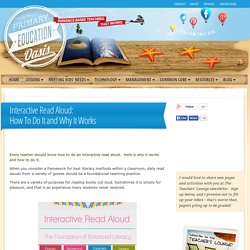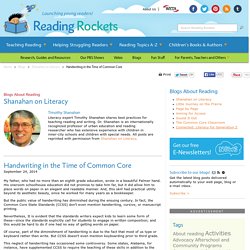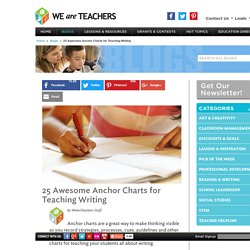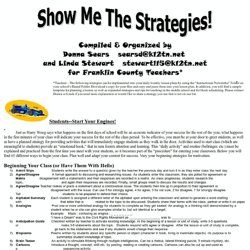

Interactive Read Aloud: How To Do It and Why It Works. Every teacher should know how to do an interactive read aloud.

Here is why it works and how to do it. When you consider a framework for best literacy methods within a classroom, daily read alouds from a variety of genres should be a foundational teaching practice. There are a variety of purposes for reading books out loud. Sometimes it is simply for pleasure, and that is an experience many students never received. Other purposes can include: develop background knowledge necessary for understanding a topictarget vocabulary developmentdemonstrate prosodylearn how to inference, make judgements and use meta-cognition strategiesintegrate higher order questioning skills set the stage for a unit or lessondevelop connections to a text (text-to-self, world or another text)meet academic content standards at a students frustration level However you choose to use reading aloud to kids, it should be done in a variety of ways across different genres, every single day.
13 Strategies to Improve Student Classroom Discussions. Questions inspire!

When educators pose thought-provoking questions to their students, they send a powerful message that students’ ideas about what they read are valuable. Great Books' professional learning courses, webinars and consultation days help educators gain new instructional strategies, pose higher-order and text-dependent questions, and encourage classroom discussion. Asking the right questions at the right time is a skill best cultivated over time.
Educators who learn the art of effective questioning help their students develop the capacity to think critically, to analyze and comprehend challenging texts, to listen carefully to new perspectives, and to communicate complex ideas both orally and in writing. To learn more about our professional learning courses, webinars and consultation days, please visit us online. The Great Books Foundation also offers a wide range of fiction and nonfiction materials that give your students the skills they need to be college and career ready. 6 Reading Comprehension Problems & What To Do About It. Handwriting in the Time of Common Core. My father, who had no more than an eighth grade education, wrote in a beautiful Palmer hand.

His oneroom schoolhouse education did not promise to take him far, but it did allow him to place words on paper in an elegant and readable manner. And, this skill had practical utility beyond its aesthetic beauty, since he worked for many years as a bookkeeper. But the public value of handwriting has diminished during the ensuing century. In fact, the Common Core State Standards (CCSS) don’t even mention handwriting, cursive, or manuscript printing. Nevertheless, It is evident that the standards writers expect kids to learn some form of these—since the standards explicitly call for students to engage in written composition; and this would be hard to do if one had no way of getting words on paper.
Of course, part of the diminishment of handwriting is due to the fact that most of us type or keyboard rather than write. 25 Anchor Charts for Teaching Writing. Anchor charts are a great way to make thinking visible as you record strategies, processes, cues, guidelines and other content during the learning process.

Here are 25 of our favorite charts for teaching your students all about writing. The Why Behind Writers Workshops Source: The First Grade Parade First and second graders will draw inspiration from this fun-filled anchor chart about why we write. DOK_Chart.jpg (JPEG Image, 1700 × 2200 pixels) - Scaled (45%) 25 Question Stems Framed Around Bloom's Taxonomy.
25 Question Stems Framed Around Bloom’s Taxonomy While critical thinking is a foundation rather than a brick, how you build that foundation depends on the learning process itself: exposing students to new thinking and promoting interaction with that thinking in a gradual release of responsibility approach.

Question stems can be a powerful part of that process no matter where the learner is. Assessment (pre-assessment, self-assessment, formative and summative assessment), prompting and cueing during discussion, etc. Write & Improve. Resources for educators of kids in grades 4-12. Show Me the Strategies. {*style:<u> </u>*} *Teachers—The following strategies can be implemented into your daily/weekly lesson plans by using the “Instructional Newsletter” Folder on your school’s Shared Folder.

Download a copy for your files and copy and paste them into your lesson plan. In addition, you will find a sample template for planning a lesson, as well as expanded strategies and tips for teaching in the middle school and for block scheduling. Please contact Donna or Linda if you need more explanation or would like to share a strategy you use that is not on our list. Just as Harry Wong says what happens on the first days of school will be an accurate indicator of your success for the rest of the year, what happens in the first minutes of your class will indicate your success for the rest of the class period. 1) Students write the answer to a question given by the teacher the previous day and turn it in as they enter class the next day. READING STRATEGIES TASK CARDS - 24 FREE PARAGRAPH CARDS.
Six Scaffolding Strategies to Use with Your Students. What’s the opposite of scaffolding a lesson? Saying to students, “Read this nine-page science article, write a detailed essay on the topic it explores, and turn it in by Wednesday.” Yikes! No safety net, no parachute—they’re just left to their own devices. Let’s start by agreeing that scaffolding a lesson and differentiating instruction are two different things. Scaffolding is breaking up the learning into chunks and providing a tool, or structure, with each chunk. Simply put, scaffolding is what you do first with kids. Scaffolding and differentiation do have something in common, though. So let’s get to some scaffolding strategies you may or may not have tried yet. 1. How many of us say that we learn best by seeing something rather than hearing about it? Try a fishbowl activity, where a small group in the center is circled by the rest of the class; the group in the middle, or fishbowl, engages in an activity, modeling how it’s done for the larger group.
The Solution to Reading Comprehension - Wow! This is an extensive database of reading comprehension lesson plans for every level of reader. it is very well organized, and easy to use. CCSS alignment included!